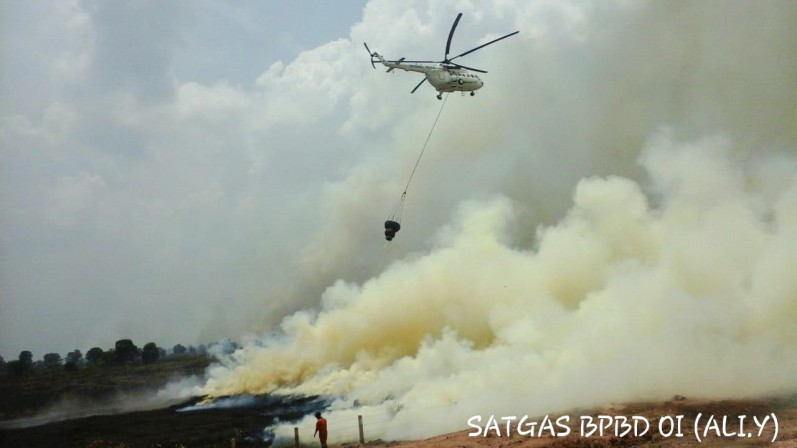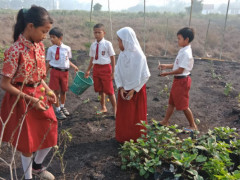Karhutla Vulnerability and Concessions Within
By AdminGeneral Election 2019 Aspirations: Awareness about Peatlands

Reflecting on the results of the previous Pantau Gambut study, namely Peatland Restoration in Gubernatorial Election turmoil, the issue of peatland ecosystem protection and the handling of forest and land fires (karhutla) have not been much of a concern among prospective regional leaders. At the national level, there is a glimmer of hope because this issue actually appears in the vision and mission of the 2019 Presidential Election candidate pairs. Will it really come to attention?
As a prerequisite for candidacy, two presidential and vice presidential candidates in the upcoming 2019 election have submitted the final document of their vision and mission to the General Election Commission (KPU) at the end of last September. From the perspective of environmental protection, these documents are quite interesting because there are specific policy directions related to forest fire prevention and handling and protection of peat.
In Nawacita's vision and mission volume II, candidate pair number 1, Joko ‘Jokowi’ Widodo – Ma’ruf Amin, places environmental issues in the fourth point of their nine missions if they are elected for 2019 - 2024. The mission reads, ‘Achieving an Environment that is Sustainable.’ In a further explanation, Jokowi-Amin will carry out this mission through mitigating the impacts of climate change by, among other things, preventing forest fires, reforesting critical lands, and continuing the conservation of peatlands.
Meanwhile, candidate pair number 2, Prabowo Subianto – Sandiaga Uno describes the direction of their policy if they lead the government in the period 2019 - 2024 in the Four Pillars of Welfare of Indonesia. The pair places an environmental-related mission on the third pillar, named 'Pillars of Culture and Environment'. Among several missions in Prabowo and Sandiaga’s environmental pillars, the eighth point reads ‘Providing the maximum punishment for company owners involved in illegal logging, forest fires, and the killing of protected endangered animals'. This point is repeated in an explanation of one of the cultural and environmental programs, namely ‘Preventing and cracking down on the perpetrators of environmental pollution and forest burning and protecting the biodiversity of flora and fauna as part of the nation's assets’.
The presence of karhutla issues in the candidate's vision and mission is likely being influenced by the momentum of the fire incident itself.
The emergence of specific karhutla-related missions from these two presidential candidate pairs does not mean that repeated fire outbreaks in Indonesia have become the focus of attention of lawmakers and potential legislators. The presence of karhutla issues in the candidate's vision and mission is likely being influenced by the momentum of the fire incident itself. If traced back, the period of registration, the completeness of registration documents, to the determination of candidates by the KPU were all done through August and September, which coincided with many of the hotspots and forest fires in a number of provinces in Indonesia. Hotspots and forest and land fires are still being monitored in many places to date.
Based on the history of forest and land fires, most of the lands burnt in the 2015 fires were peatlands. These forest and land fires also led to the establishment of the Peatland Restoration Agency (BRG) which has a mandate to coordinate the restoration of 2.49 million hectares of peatland during the 2016-2020 period. The existence of BRG thus far has at least ensured that there are activities actually being carried out for peat restoration. The main goal is of course that the 2015 forest fires will no longer be repeated, especially in peat areas which, if burned, will be difficult to extinguish due to the high carbon content.
However, thousands of hotspots and fires were detected in all parts of Indonesia in recent months. During the peak of the dry season in August 2018 alone, Pantau Gambut, through spatial analysis, detected 1967 hotspots with high-confidence in priority provinces for peat restoration, namely Riau, South Sumatera, Jambi, West Kalimantan, Central Kalimantan, South Kalimantan, and the Papua region (including Papua dan West Papua). This number does not distinguish between hotspots that have been extinguished or those still repeated the next day. Of this total, around 57% are within the Peat Hydrological Unit (KHG) which became the priority for the restoration program of 2.49 million hectares and/or in the land clearing moratorium area. Field observations carried out by Simpul Jaringan Pantau Gambut also found locations of fires that occurred on peatlands, moratorium areas, as well as corporate concession areas.
In some areas, especially South Kalimantan, the situation worsened in late September as smoke from fires had disrupted flight schedules. Concerns also began to emerge in the South Sumatra region after the Asian Games event. In late August to early September, massive land and air operations that were launched as an effort for the biggest sports event in Asia, were able to quell a number of hotspots and karhutla in the province. However, at present, a number of units operating to secure Asian Games have been withdrawn from the field.
Prevention and handling of forest and land fires must be in step with improvement in the implementation of peat restoration in terms of transparency in execution, especially in cultivation areas, that monitoring and evaluation functions in ensuring the quality of restoration infrastructure and karhutla management, coordination between institutions, and law enforcement.
Regardless of weather factors and estimates that 2018 will be one of the hottest years in history, the presence of hotspots and forest fires in priority restoration locations is a test of the effectiveness of peat restoration activities to date. Pantau Gambut’s recommendations to leaders and prospective leaders is for the direction of their policy plan for the prevention and handling of forest and land fires to look at the reality of what happened. Prevention and handling of forest and land fires must be in step with improvement in the implementation of peat restoration in terms of transparency in execution, especially in cultivation areas, that monitoring and evaluation functions in ensuring the quality of restoration infrastructure and karhutla management, coordination between institutions, and law enforcement.
Restoring the peat which is already damaged is certainly not an easy job and will not be completed until the period of 2020 which is the deadline for BRG's mandate. Continuing restoration work after 2020 requires firm commitment and direction, particularly if restoration is seen as part of peat conservation efforts.
Will there be a sense of peat in the upcoming 2019 election? Or will all campaign promises fade with the arrival of the rainy season? Let's monitor them.



